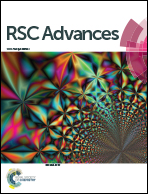A low molecular mass organogelator electrolyte with TiO2 nanoparticles for stable and efficient quasi-solid-state dye sensitized solar cells†
Abstract
We report stable and efficient quasi-solid-state dye-sensitized solar cells (QS-DSSCs) fabricated using a combination of TiO2 nanoparticles and a low-molecular-mass organogelator (LMOG) as a nanoparticle–gel composite electrolyte. Three types of electrolyte, namely liquid, LMOG-based gel, and nanoparticle–gel composite, are used. The results of electrochemical impedance spectroscopy and intensity-modulated photocurrent/photovoltage spectroscopy measurements suggest that the presence of TiO2 nanoparticles in the nanoparticle–gel composite electrolyte could afford faster electron transport and a longer electron recombination time compared to the liquid and LMOG-based gel electrolytes. The QS-DSSC using the nanoparticle–gel composite electrolyte with the optimal TiO2 content exhibits a power conversion efficiency of 7.79%, which is significantly higher than that of devices using the liquid (7.22%) and LMOG-based gel (7.21%) electrolytes. Remarkably, the QS-DSSCs with the optimal nanoparticle–gel composite electrolyte exhibit long-term stability over 10 days, unlike the liquid electrolyte-based cells.



 Please wait while we load your content...
Please wait while we load your content...